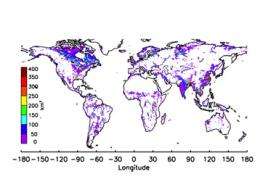Population pressure impacts world wetlands

(Phys.org) -- The area of the globe covered by wetlands (swamps, marshes, lakes, etc.) has dropped by 6% in fifteen years. This decline is particularly severe in tropical and subtropical regions, and in areas that have experienced the largest increases in population in recent decades. These are the conclusions of a study conducted by CNRS and IRD researchers from the Laboratoire d'étude du rayonnement et de la matière en astrophysique, Laboratoire d'études en géophysique et oceanography spatiales and the start-up Estellus. To obtain these results, the scientists performed the first worldwide mapping of the wetlands and their temporal dynamics, for the years 1993 to 2007. This study, which has just been published in the journal Geophysical Research Letters, emphasizes the impact of population pressure on water cycles.
Marshes, lagoons, swamps and bogs are all types of wetlands—regions where water is the main controlling factor for the environment and its plant and animal life. Although they cover less than 5% of the Earth's land surface, these areas play a key role in human activities, biodiversity, climate and the water cycle. Indeed, they produce one third of atmospheric methane, a major greenhouse gas. Moreover, these regions impact the transfer of continental freshwater to the sea and alter local weather by enhancing evaporation.
A better understanding of wetlands, their way of functioning and their variability and dynamics over time, are essential for assessing climate change and making sound recommendations for water resource management. Characterizing wetland distribution and quantifying seasonal and inter-annual variations across the globe is, however, a huge challenge. No similar study had ever been undertaken until now, as these areas are diverse and spread across the whole planet from the tropics to the Arctic.
By combining and simultaneously analyzing a large amount of data from different satellites, the researchers succeeded in developing the first mapping of wetlands and their temporal dynamics throughout the world over fifteen years. The first conclusion from this study is that the extent of wetlands varied greatly during any year, but also from one year to another, with strong modulation during El Niño events. Moreover, between 1993 and 2007, scientists observed a 6% fall in wetland areas. This trend was particularly severe in tropical and subtropical regions. The highest declines are concentrated in the areas where the largest increases in human population have been recorded over the last two decades.
This study suggests that population pressure impacts hydrological cycles at the global scale. This pressure may stem from the draining of wetlands for urban development and the increase in water extraction from wetlands.
More information: Changes in land surface water dynamics since the 1990s and relation to population pressure, Prigent, C., F. Papa, et al., Geophys. Res. Lett., doi:10.1029/2012GL051276 , in press (2012).
Journal information: Geophysical Research Letters
Provided by CNRS
















